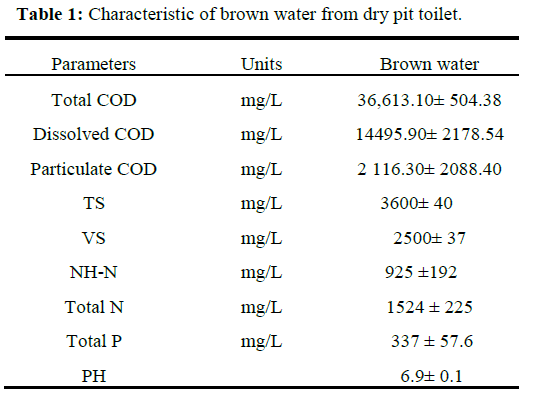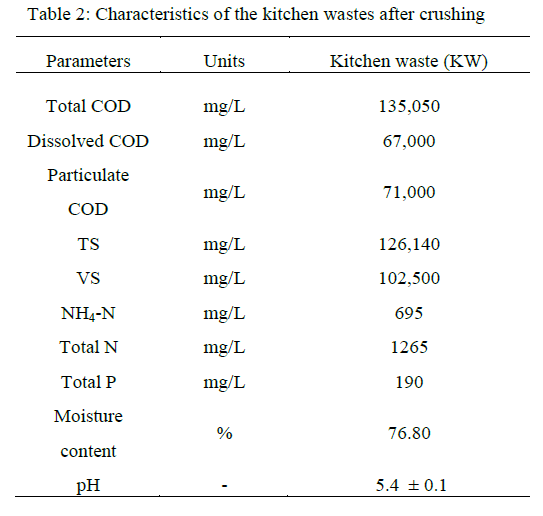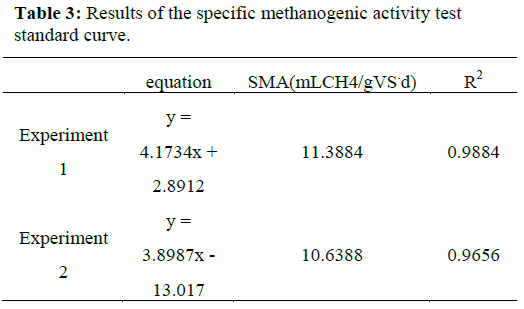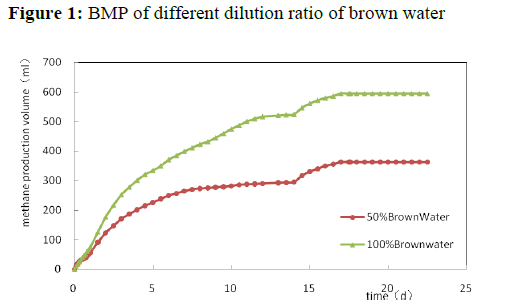
Journal of Fundamentals of Renewable Energy and Applications
Open Access
ISSN: 2090-4541

ISSN: 2090-4541
Short Communication - (2020)Volume 10, Issue 5
The house hold waste stream generation and treatment techniques are still limited. Waste source separation including separate treatment of graywater, brown water and black water are necessary for a sustainable integrated water management application. In this study, each of the waste, notably brown water and food waste biochemical methane potential mix ratio (1:1; 4:1) were investigated to ascertain their energy value. Without the dilution of the household kitchen wastes (100 %), the average biochemical methane potential was 484 mL CH4/gVS, when the household kitchen waste dilution rate was 50 %, the methane value was 983 mL CH4/gVS. Although household kitchen wastes can be easily biodegraded, their biochemical methane potential decreased if it was highly diluted (50 %).These variations may be attributed to the increased ratio of the inoculum to the substrate, which increased the concentration for microbial dynamics and provided adequate nutrients for microbial growth。For different ratio between household kitchen waste and brown water, the biochemical methane potential had Fa great difference. When the KW: BW=1:1, the average BMP was 186.6mLCH4/gVS-add and KW:BW=4:1, the number was 112.2 mLCH4/gVS-add. These findings could offer the potential as a source of renewable energy generated through processing the brown water and food waste.
Household Kitchen Waste, Brown Water, Source Separation, Biochemical Methane Potential, Codigestion
The collection, treatment, and holistic utilization of food waste remain limited, and feces are mainly flushed directly into the sewers of centralized sewage management plants [1]. The quantities of these wastes are generally in the average weight between 350 g (feces) and 400 g (food waste).There is need to mitigate these wastes’ severe environmental impact and harness their inherent resources. Separation of household waste water system (Black water, grey water, brown water and yellow water is a viable option for waste water resource management and energy potential treatment [2]. In the waste management of these waste streams there is need to identify individual waste streams or combined that can offer different scenario on their potentials. AD has been extensively applied in the separate biodegradation of organic waste, such as food wastes [3] and household wastewater substrates [4].
From the energy and resource recovery viewpoint, anaerobic digestion (AD) can be applied to treat brown water and recover energy for methane in the generated biogas. Different microorganisms participated in each of the degradation steps [5] . Irrespective of the efficiency of the AD in resource recovery and treatment of organic waste several problems do occur such as ammonia, organic acid accumulation, and process instability due to inhibition [6-8]. The performance of these waste treatments via AD and their energy potential can be improved via co-digestion. Codigestion would offer an effective method to improve methane generation and balance the household waste stream COD:N ratio with kitchen wastes [9-10]. If digested together, these sources are a beneficial resource for energy and nutrient production. [11-13] reported the benefits associated with the codigestion of domestic wastes and black water.
Collection of Brown Water, Kitchen Waste and Inoculum
To obtain brown water (dry feces) were excavated from a community pit toilet and further mixed with a suitable proportion of water. The characteristics of the brown water used in this study are shown in Table 1. Mixing 138 g of dry feces and 1 L of flush water provided brown water with the desired characteristics for use as the feedstock in this research.

Kitchen wastes were collected from canteen. The main constituents of the kitchen waste are vegetable and fruit wastes with minor fractions of meat and bone. The waste was blended to have homogenized mixture and further characterized (Table 2). For the co digestion, the kitchen wastes and brown water were mixed at various ratios for the biochemical methane potential test.

Inoculum sludge was taken from a mesophilic continuous stirred sludge tank reactor digester at 35 °C in the water environmental (wastewater) division research laboratory of Tsinghua University. The digester was operated at HRT of 30 days, and the specific methanogenic activity of the sludge was evaluated in accordance with the protocol of [14]. The total chemical oxygen demand (TCOD), soluble chemical oxygen demand (SCOD), total solid (TS), volatile solid (VS), total nitrogen (TN), total phosphorus (TP), and ammonia–nitrogen (NH4+-N) of the substrates (brown water and kitchen waste) were determined.
Inoculum-Specific Methanogenic Test
The sludge used to determine the biochemical methane potential must be subjected to a specific methanogenic test to identify its ability to avoid endogenous reaction from residual organic matter and to determine its suitability for biogas production. The operational methods are as follows. The TS and VS concentration for the sample sludge to be analyzed was determined 12 h in advance before commencing the test. A mineral stock solution was mixed with the sludge in the reactor for the specific methanogenic test. Sodium hydroxide (NaOH) was added to adjust the pH of the reactor content to 6.8–7.0, and the reactor content temperature was maintained at 35 ± 0.5 °C. Nitrogen gas was used to flush the reactor for 15 min at 5– 10 psi. The test samples were acclimatized for 12 h. The reactor motor was not switched on until the commencement of the test. Prior to the start of the test, the test reactors were flushed again with nitrogen gas for 5 min. The substrate was inserted via a latex septum feeding line, the motor was switched on, and the gas level after 2–3 min was recorded through the graduated cylinder. Gas production was noted per hour. On the basis of the specific methanogenic activity, gas composition was analyzed every hour for the methane volume produced as mLCH4/gVS.
Biomethane potential test for the co-digested kitchen wastes and brown water
The analytical procedure for the biochemical methane potential test for the substrate (kitchen waste and brown water codigestion) is as follows. (1) A total of 120 mL of sludge was added to a 500 mL glass vial. (2) The AD media was added at different proportions (i.e., 2, 0.4, and 0.2 mL), and 0.1 g of cysteine hydrochloride was added. (3) NaHCO3 (0.52 g), Na2S.9H2O (0.05 g), or NaOH was used to adjust the pH to 6.8–7.0 in each vial. (4) Nitrogen gas was used to flush the bottles for 1 min. Thereafter, each bottle was kept in a water bath at their respective temperatures. (5) After 2 days, 80 mL of household kitchen wastes and brown water were added to the bottles at different codigestion mix ratios (1:1, 4:1) for the biochemical methane potential test. (6) The pH was further adjusted to 6.5–7.0. The bottles were flushed once again with nitrogen gas, and the data software was restarted. The experiment on the samples and substrates were performed in triplicates with blanks.
Physicochemical Analytical Procedure
Digestion kits containing diols and dichromate (Hach, LCK 514) were used to determine COD. After a color change, spectrophotometry (DR6000, HACH Company, Germany) was conducted after oxidation for 2 h at 150 °C with cuvette tests at 620 nm wavelength. A rotor-stator was initially used to homogenize the crushed kitchen waste, which was centrifuged at 15,000 rpm for 20 min. The kitchen waste sample was diluted 100 times and homogenized for TCOD analysis. The COD particulate fraction was analyzed by deducting the SCOD from the total COD. The COD concentration of the samples was filtered using a 0.45 μm cellulose acetate membrane. SCOD and TCOD analyses were conducted consistent with previously described analytical techniques [15-17]. TN and TP were analyzed via the photometrical method using a cuvette in HACH DR 5000. TP was digested with persulfate to oxidize phosphorus into SP. The blue color generated by phosphorus molybdenum was photometrically determined after the additon of ascorbic acid, 2 M antimony, and 1 M molybdate. The 0.45 μm soluble filtered fraction was used to determine NH4+-N. It was analyzed using spectrophotometry (DR-5000, Hach, USA) after the addition of hypochlorite and salicylate to generate monochloramine, which was measured inline (APHA/WEF/AWWA, 1989).
A small sample volume of the crushed kitchen waste stored in a weighed crucible was heated for 24 h at 105 °C until moisture was evaporated. The sample was weighed again after cooling down in a desiccator. The differences in sample weight before and after evaporation and the crucible reflected the TS value. For the determination of VS, the sample was further burnt in an oven at 550 °C for 2 h. The sample was weighed again after cooling down in a desiccator. The difference between the weight of the sample before and after burning and the crucible denoted the VS value. Such a difference was determined in accordance with a previously described method [16,18] .
Specific Methanogenic Activity
The specific methanogenic activity test would provide suitable conditions for bioprocess operations, and its parameters are an indication of its stability and inhibition. The methane generation efficacy and methanogenic capability of the sludge for specific substrate utilization are evaluated via the specific methanogenic test [19] . Given the importance of the specific methanogenic activity test in the current study, the commencement of the start-up of the new digester was assisted to ensure that no endogenous biogas production from any residual organic matter interfered with feedstock utilization given that its methane potential was also understood. In addition, the changes in the specific methanogenic performance of the sludge indicated whether its degradability was reduced or hindered by nonbiodegradable organic matters. The experimental results for the specific sludge methanogenic activity in the biochemical methane production are shown in table 3.

Specific methanogenic activity test for the start-up phase of the organic loading rate is most appropriate for the digesters of municipal wastewater treatment plants. These results indicated that the specific methanogenic activity of the sludge was high and suitable for the biochemical methane potential test of kitchen waste and brown water.
Biochemical methane performance of the kitchen wastes and brown water
The potential methane performances of the kitchen wastes and brown water at different individual dilution ratios showed variable methane generation trends over the experimental period. From the Fig. 1, we can deduce that the methane production volume of brown water reached the optimal within seventeen days. From the Table 1. Brown water has high COD to total nitrogen ratio between 23 and 24 and the dissolved COD has a proportion about 39.6%; the VS to TS ratio is about 69.4%; the pH of brown water is around 6.9. From the characteristic of brown water present above, we can infer that it perhaps also can be anaerobic biodegradability to generate biogas.

However, the biochemical methane potential for different dilution ratios had an enormous difference. Without the dilution of the household kitchen wastes (100 %), the average biochemical methane potential was 484 mL CH4/gVS, which is within the previously reported specific biochemical methane potential value of food waste [20].
By contrast, when the household kitchen waste dilution rate was 50 %, the methane value was 983 mL CH4/gVS. Although household kitchen wastes can be easily biodegraded, their biochemical methane potential decreased if it was highly diluted (50 %). These variations may be attributed to the increased ratio of the inoculum to the substrate, which increased the concentration for microbial dynamics and provided adequate nutrients for microbial growth. This drift was nearly similar to the observations of biochemical methane potential tests on food waste, feces, and tissue paper, where a high inoculum ration of 40% enhanced active microbial activities [1]. For different ratio between household kitchen waste and brown water, the biochemical methane potential had a great difference. When the KW: BW=1:1, the average BMP for the three parallel experiments was 186.6mLCH4/gVS-add and KW:BW=4:1, the number was 112.2 mLCH4/gVS-add Table 5.
These phenomena can be attributed to the reduction in inhibition with the increase in kitchen waste content and reduction in the brown water concentration. Due to the concerns of inhibition from ammonia accumulation, the addition of brown water alone (with- out urine) to kitchen waste prior to AD has been previously investigated [21]. Given that the ratio of kitchen wastes to brown water was reduced, these occurrences were slightly similar to those observed for black water and kitchen waste mix ratios of 1:2 and 1:3 that generated high biochemical methane potentials of 680 ± 58 and 630 ± 52 Nml CH4/gVS, respectively [4].
From the results presented above, we may conclude that KW:BW=1:1 was better than KW:BW=4:1. It may result from the different C : N after mixture. When KW:BW = 1:1, the C:N is 62.3 while KW:BW=4:1, the C: N is 75.2. The anaerobic bioprocess codigestion of human feces, food waste, and other organic wastes provides advantages that enhance the robust and stable performance of this process [1], The concentrations of their co-digested substrates and mix ratios may have contributed to the slight differences in TCOD removal efficiency of ~ 90 % [4] reported an improvement in biochemical methane potential under balanced COD: NH4–N ratio (100:6–7) conditions. NH4+-N concentration of the co-digested substrate slightly increased to 1021 ± 0.2 without any observable inhibition [13] reported that the degradation of ammonia, carbonates, and urea in high concentrations of brown water promoted the buffer efficiency of bioprocesses. The reduction in the effluent VS and COD physicochemical parameters reflected the efficiency of the codigestion treatment of kitchen wastes and brown water in nutrient and energy recovery with bioprocess technology.
Conclusion
This study investigated the effects of the codigestion of household kitchen wastes with brown water on biochemical methane potential. The biochemical methane potential increased with the increase in the amount of kitchen waste in the substrate. The mix ratio of kitchen wastes:brown water of 4:1 generated the lowest biochemical methane potential of 112.2 mLCH4/gVS-add compared to 1:1 with the average BMP of 186.6mLCH4/gVS-add. This can be attributed to the comparative balance in substrate concentrations that offered robust anaerobic digestion stability and withstood inhibitions. This finding suggested a practicable basis for the management of household organic wastes (brown water and kitchen waste) to enable nutrient and energy recovery and avert the challenges associated with the disposal of individual waste.
References
- Kim Jaai, Kim Jinsu and Lee C. Anaerobic co-digestion of food waste, human feces, and toilet paper: Methane potential and synergistic effect Fuel. 2019; 248:189-195 https://doi.org/10.1016/j.fuel.2019.03.081
- Elmitwalli T.A, Van Leeuwen M, Kujawa-Roeleveld K., Sanders W and Zeeman G. Anaerobic biodegradability and digestion in accumulation systems for concentrated black water and kitchen organic-wastes. Water Sci Technol. 2006; 53:167–176. https://doi.org/10.2166/wst.2006.247
- Giwa A.S, Xu H, Chang F, Wu J, Li Y, Ali N, Ding S and Wang K. Effect of biochar on reactor performance and methane generation during the anaerobic digestion of food waste treatment at long-run operations. J Environ Chem Eng. 2019; 7:103067. https://doi.org/10.1016/j.jece.2019.103067
- Zhang L, Guo B, Zhang Q, Florentino A, Xu R, Zhang Y and Liu Y. Co-digestion of blackwater with kitchen organic waste: Effects of mixing ratios and insights into microbial community. J Clean Prod. 2019; 236:117703. https://doi.org/10.1016/j.jclepro.2019.117703
- Angelidaki I, Treu L, Tsapekos P, Luo G, Campanaro S, Wenzel H and Kougias P.G. Biogas upgrading and utilization: Current status and perspectives. Biotechnol Adv. 2018; 36:452–466. https://doi.org/10.1016/j.biotechadv.2018.01.011
- Capson-Tojo G, Girar C, Rouez M., Crest M, Steyer J.P, Bernet N, Delgenès J.P and Escudié R. Addition of biochar and trace elements in the form of industrial FeCl 3 to stabilize anaerobic digestion of food waste: dosage optimization and long-term study. J Chem Technol Biotechnol. 2019; 94:505–515. https://doi.org/10.1002/jctb.5797
- Fagbohungbe M.O, Herbert B.M.J, Hurst L, Ibeto C.N, Li H, Usmani S.Q and Semple K.T. The challenges of anaerobic digestion and the role of biochar in optimizing anaerobic digestion. Waste Manag. 2017; 61, 236–249. https://doi.org/10.1016/j.wasman.2016.11.028
- Giwa A.S, Xu H, Chang F, Zhang X, Ali N, Yuan J and Wang K.. Pyrolysis coupled anaerobic digestion process for food waste and recalcitrant residues: Fundamentals, challenges, and considerations. Energy Sci Eng. 2019; 7:1–15. https://doi.org/10.1002/ese3.503
- Ros M, de Souza Oliveira Filho J, Perez Murcia M.D, Bustamante M.A, Moral R, Coll M.D, Lopez Santisima-Trinidad A.B and Pascual J.A. Mesophilic anaerobic digestion of pig slurry and fruit and vegetable waste: Dissection of the microbial community structure. J Clean Prod. 2017; 156:757–765. https://doi.org/10.1016/j.jclepro.2017.04.110
- Zamanzadeh M, Hagen L.H, Svensson K., Linjordet R and Horn S.J. Anaerobic digestion of food waste - Effect of recirculation and temperature on performance and microbiology. Water Res. 2016; 96:246–254. https://doi.org/10.1016/j.watres.2016.03.058
- Kujawa-Roeleveld K. and Zeeman G. Anaerobic treatment in decentralised and source-separation-based sanitation concepts. Rev Environ Sci Biotechnol. 2006; 5:115–139. https://doi.org/10.1007/s11157-005-5789-9
- Luostarinen, S. Anaerobic on-site wastewater treatment at low temperatures. Dep Biol Environ Sci B.Sc. 2005; 85.
- Wendland C, Universit T and Wendland C. Anaerobic Digestion of Blackwater and Kitchen Refuse Hamburger Berichte zur Siedlungswasserwirtschaft Anerobic Digestion of Blackwater and Kitchen Refuse. 2014. https://doi.org/10.15480/882.478
- Angelidaki I, Alves M, Bolzonella D, Borzacconi L, Campos J.L, Guwy A, Kalyuzhnyi S.,Jenicek P and Van Lier J.B. Defining the biomethane potential (BMP) of solid organic wastes and energy crops: A proposed protocol for batch assays. Water Sci Technol. 2009; 59:927–934. https://doi.org/10.2166/wst.2009.040
- Fagbohungb M.O, Herbert B.M.J, Hurst L, Li, H, Usmani S.Q and Semple K.T. Impact of biochar on the anaerobic digestion of citrus peel waste. Bioresour Technol. 2016; 216:142–149. https://doi.org/10.1016/j.biortech.2016.04.106
- Giwa A.S, Chang F, Xu H, Zhang X, Huang B, Li Y, Wu J, Wang B, Vakili M and Wang K. Pyrolysis of difficult biodegradable fractions and the real syngas bio-methanation performance. J Clean Prod 2019; 233:711–719. https://doi.org/10.1016/j.jclepro.2019.06.145
- Kim M, Chowdhury M.M.I, Nakhla G and Keleman M. Characterization of typical household food wastes from disposers: Fractionation of constituents and implications for resource recovery at wastewater treatment. Bioresour Technol. 2015; 183:61–69. https://doi.org/10.1016/j.biortech.2015.02.034
- APHA. Standard Methods for the Examination of Water and Wastewater. 19th Edition. Am Public Heal Assoc. 1995.
- Hussain A and Dubey S.K. Specific methanogenic activity test for anaerobic degradation of influents. Appl Water Sci. 2017; 7:535–542. https://doi.org/10.1007/s13201-015-0305-z
- Kobayashi T, Xu K.-Q, Li Y.Y and Inamori Y. Evaluation of hydrogen and methane production from municipal solid wastes with different compositions of fat, protein, cellulosic materials and the other carbohydrates. Int J Hydrogen Energy. 2012; 37:15711–15718. https://doi.org/10.1016/J.IJHYDENE.2012.05.044
- Lavagnolo M.C, Girotto F, Hirata O and Cossu R. Lab-scale co-digestion of kitchen waste and brown water for a preliminary performance evaluation of a decentralized waste and wastewater management. Waste Manag. 2017; 66:155–160. https://doi.org/10.1016/j.wasman.2017.05.005
Author Info
Abdulmoseen Segun Giwa1*, Abdul Ghaffar Memon2, Emmanuel Alepu Odey3, Jabran Ahmad4, Gilbert Adie5 and Baozhen wang11Green Intelligence Environmental School, Yangtze Normal University, Chongqing, 408100, P.R. China
2Department of Environmental Engineering, NED University of Engineering and Technology, Pakistan
3Department of Environmental Engineering, University of Science and Technology, Beijing, China
4State key joint laboratory of ESPC, School of Environment, Tsinghua University, Beijing 100084, China
5Chemistry Department, University of Ibadan, UI, Oyo 200284, Nigeria
, DOI: 10.35248/2090-4541.20.10.283
Copyright: This is an open access article distributed under the terms of the Creative Commons Attribution License, which permits unrestricted use, distribution, and reproduction in any medium, provided the original work is properly cited.